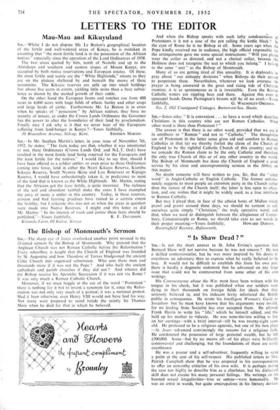LETTERS TO THE EDITOR
Mau-Mau and Kikuyuland
SIR,—Whilst I do not dispute Mr. Le Breton's geographical location of the fertile and well-watered areas of Kenya, he is mistaken in assuming that "the most fertile land is in the possession of the African natives " especially since the operation of the Land Ordinances of 1938.
The two areas quoted by him, north of Nairobi and up to the Aberdares and southern and eastern slopes of Mount Kenya, are occupied by both native reservations and European estates. Of these, the most fertile and scenic are the "White Highlands," situate as they are on the plateau sheltered by and beneath the snows of these mountains. The Kikuyu reserves are split up into small holdings few above five acres in extent, yielding little more than a bare subsis- tence as shown by the stunted growth of their cattle.
On the other hand the European farms and ranches run from 400 acres to 4,000 acres with huge fields of wheat, barley and other crops and large herds of cattle. Furthermore Mr. Le Breton is in error when he speaks of " possession " by African natives; they have no security of tenure, as under the Crown Lands Ordinance the Governor has the power to alter the boundaries of their land by proclamation. Finally may I ask why is it that we never hear of the Europeans suffering from land-hunger in Kenya ?—Yours faithfully,
30 Braundton Avenue, Sidcup, Kent. STEPHEN MARTIN.


































 Previous page
Previous page